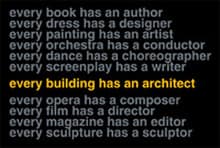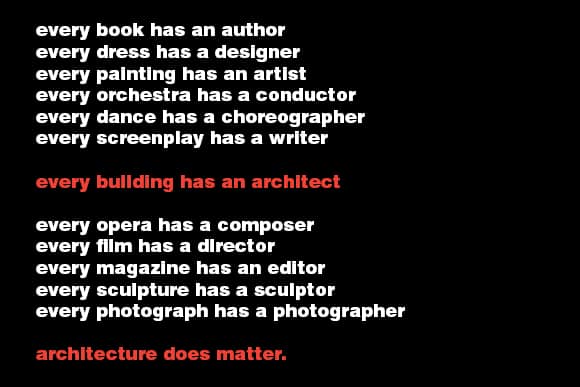Jared’s Note: Jeremiah originally wrote this post for his own site. I asked him if I could share it on Shoegnome because it fits so well with the recent discussions on the use of the word architect and what to call people who work in the field, but aren’t licensed architects. Turns out Canada has a nice solution already. Jeremiah graciously said yes to letting me repost and also promised me at least one follow up piece. Which is awesome. By the way, you can read all the posts on this topic here.
 A few years ago Architecture Canada launched their campaign entitled “Every Building has an Architect.” This campaign seeks to raise the profile of architects in the public’s eye and to “encourage the practice of crediting architects when using images of buildings in the media.” I applaud their efforts whole-heartedly as this is an issue that is dear to me. The buildings we inhabit, work in, buy goods from, and educate our children in have significant impacts on our society through their impacts on us as individuals and on the environmental context they are in. But there are others who can design buildings as well.
A few years ago Architecture Canada launched their campaign entitled “Every Building has an Architect.” This campaign seeks to raise the profile of architects in the public’s eye and to “encourage the practice of crediting architects when using images of buildings in the media.” I applaud their efforts whole-heartedly as this is an issue that is dear to me. The buildings we inhabit, work in, buy goods from, and educate our children in have significant impacts on our society through their impacts on us as individuals and on the environmental context they are in. But there are others who can design buildings as well.
In truth, the campaign should say, most buildings have architects, all buildings have designers. In Ontario and all other provinces and territories in Canada, designers who are not architects are permitted to design and prepare construction documentation for buildings that fit within certain classifications. Each provincial and territorial association of architects sets limits on what these designers can design based on the floor area of the building and the particular occupancy type. These limits are enforced by the architects acts in each province/territory. There is considerable variation among the different associations as to the size of the building that is permitted, with Quebec being the most restrictive, the prairies and territories being the least restrictive, and the rest falling somewhere in between.
About six years ago in Ontario, the Ministry of Municipal Affairs and Housing (MMAH) introduced a new system wherein non-architect designers must now become registered with them in order to be permitted to provide design services to the public (i.e. designing anything other than their own property.) To become registered, designers have to pass a series of examinations proving competency in the Ontario Building Code and Building Code Act and have to carry professional liability insurance (aka errors & omissions insurance.) After becoming registered, a designer is issued a Building Code Identification Number (BCIN) that permits them to design buildings in accordance with the particular classification they’ve received (either house or small buildings.) See MMAH’s Qualification and Registration Page for more information.
The Ontario Architects Act generally limits the public (including those with a BCIN) to designing commercial buildings and residential townhouses with a maximum height of three storeys and a maximum gross floor area of 600 m2 (6450 sq.ft.) There is no area limit on one and two unit houses/duplexes provided they’re not built on top of each other. Not permitted is work on any building with an assembly or care facility occupancy (schools, reception halls, churches, nursing facilities, hospitals, or restaurants.)
Unique to Ontario, is a separate class of membership under the Architects Act called Licensed Technologist OAA (Lic.Tech.OAA). These designers, who are experienced and skilled architectural technologists are licensed by the same organization as architects: the Ontario Association of Architects (OAA.) As such, they are not required to have a BCIN from the MMAH. They are provided with licenses same as architects but with certain terms, conditions, and limits. In short these terms, conditions, and limits allow a Lic.Tech.OAA to perform services similar to other designers with the additional ability to design residential buildings up to four storeys in height, apartment buildings and condominiums, and restaurants up to 100 seats.
Aside from Architects, Licensed Technologists, and MMAH-registered designers, there are also talented interior designers and interior decorators that are skilled at providing design services for residential and commercial buildings.
Add a comment or send me an email if you have any questions about when a particular type of designer or consultant is required.

7 thoughts on “Guest Blogger Jeremiah Gammond: Every Building has an Architect(ural Technologist…)”
For a long time its seemed strange to me that in the U.S. the same license that permits a designer to design and stamp drawings for a hospital is the same license as required for high rise apartments is the same as airplane hangers is the same as concrete and steel manufacturing facilities is the same as low rise apartments is the same as light wood frame houses is the same as….
Maybe this is the solution; everyone with ‘x’ education qualifies to take an exam for the building type, occupancy type or program type they are most likely to face in their design careers. Or maybe this is just causing more problems with policing designers (you hold x license but designed y building!!!)
Hi Patrick. It’s the same in Canada for architects and engineers. It’s through the professional code of conduct and ethics portions of the respective associations’ acts, bylaws, and regulations that require professionals to act within their area of experience and expertise. So, if you’re a structural engineer and all you’ve designed is bridges and low-rise apartments then you break-out and design a 50 storey high-rise and it turns out to be a disaster because you truly didn’t know what you were doing, then it’s pretty likely that aside from a lawsuit, you’d be facing the complaints and probably the discipline committee of your organization.
In Ontario, we’ve run into a slight problem (at least in my eyes) that architects and engineers are exempt from obtaining a building code identification number (discussed above.) The issue is the exemption is too vague. Meaning, an electrical engineer is exempt from all requirements for small buildings and could conceivable design a small apartment building without the need for proving he/she knows anything about structure, mechanical, or architectural.
The other issue — in Ontario at least — is that the acts for architects and engineers vary in one important aspect, which has led to a lot of confusion in the public. Engineers are permitted to review and stamp the work of others (and consequently taking responsibility for the design) whereas architects are not.
Are we interested in issues other than safety and beauty? Do we have confidence in our tests to identify competence in these areas? Are we sure our public officials will catch errors in design in a timely manner? Most good architecture depends on the cooperation of persons with diverse talents. Name one academic program for master building. Why are architects so shy writing about building costs? Maybe all designers should be required to maintain a public portfolio of their test scores (with the tests), completed projects with peer reviews, and professional endorsements from schools and associations.
Jeremiah,
I’m unclear what tests or qualifications are required of Lic. Tech. OAA applicants. Perhaps you can clarify. Thanks.
Hi Geoff, are you in Ontario by any chance? There is a comprehensive “program guide” at the Ontario Association of Applied Architectural Sciences (OAAAS) website, found here: http://www.oaa.on.ca/the%20oaa/allied%20organizations/oaaas (look under “Downloads/forms” at the right side of the page.)
The first step is education. You have to be a technologist by obtaining a three year diploma in architectural technology in an accredited college or equivalent. If you’re not a technologist, you may have to be certified by another organization first. The second step is experience. Once you become a member of OAAAS, you must be employed by an architect and log experience in an experience record book modeled after the CERB that all Canadian architects must complete during their internship. Once a certain amount of experience is obtained, then you can sit at the OAA Admission Course, which is a three-day lecture series shared with intern architects. After this, then their is a one day examination on topics covering the full range of the practice of architecture. Successfully pass these steps, then you can apply to the OAA registrar for a license and a seal/stamp. You can retroactively submit all of your experience hours if you’ve already been in the profession for a number of years provided the supervising architect can sign off on them. Additionally, there is also an advanced standing policy for experienced technologists who can’t otherwise complete the program (you’re a technician, supervising architect can’t sign off on experience, foreign experience, etc.)
To operate on your own, as I do, then you have to apply for a Certificate of Practice and obtain professional liability insurance from Prodemnity Insurance (owned by the OAA.)
I’m currently the president of OAAAS, so feel free to ask me any questions about the program.
No, I’m in Seattle. Just curious about the process there. Sounds like there are a few official designations available. Here in WA it’s Architect, if you qualify to use the title, or some name you devise for yourself if you do not.
With respect to being an architectural technologist, I’m curious if someone can provide some input on the designation in other jurisdictions. Are their any restrictions on the use of the designation in any of the states? What about in Europe or Australia?